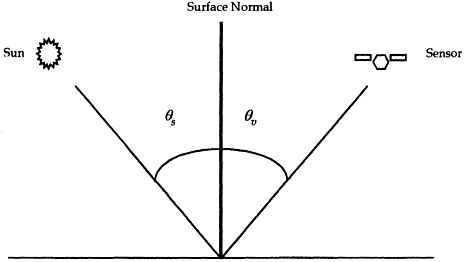69.
| [Cover] [Contents] [Index] |
Page 16
The term τ is known as the optical depth, and θs is the solar zenith angle, which is illustrated in Figure 1.9.
A fraction of the solar radiation that is scattered into the atmosphere will also appear to contribute to the illumination of the ground target (Figure 1.8c, marked ‘diffuse’) and will compensate for some of the attenuation of the direct beam. If we denote this diffuse skylight as td(θs), then the fraction of solar irradiance incident at the ground target becomes:
 |
(1.4) |
A second scattering flux that should also be taken into consideration is the trapping mechanism. The effect of this mechanism corresponds to the successive reflection and scattering of solar radiation between the ground target neighbourhood and the atmosphere, so that the radiation then becomes incident upon the ground target, as shown in Figure 1.8d and e. The magnitude of this effect depends on the spherical albedo of the atmosphere, S, and the surface reflectance, ρs. The illumination at the ground target now becomes:
 |
(1.5) |
The proportion of the solar radiation reflected from the ground target is expressed as:

Figure 1.9 Solar and sensor view angles on a horizontal surface.
| [Cover] [Contents] [Index] |
EAN: 2147483647
Pages: 354